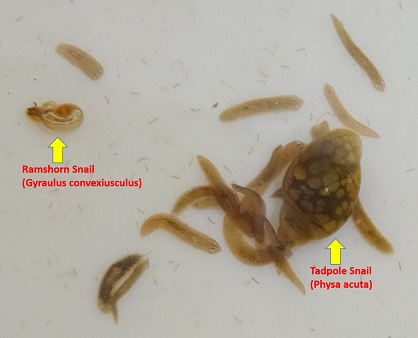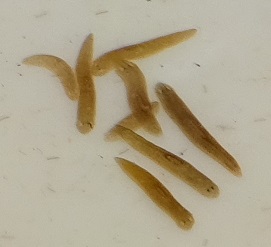| Home | Nature Weekly Index |
10 July 2016 | Freshwater Planarian | Flatworm |

 After observing planaria, a type of freshwater flatworms, swimming in my mini fish tank
back in May, I started to take a closer look at their
activities. So far, they did not seem to mess up the aquatic environment and they did not attack the only fish kept
in this particular tank. In fact, the more problematic creatures were the small aquatic snails in all the 3 fish tanks.
After observing planaria, a type of freshwater flatworms, swimming in my mini fish tank
back in May, I started to take a closer look at their
activities. So far, they did not seem to mess up the aquatic environment and they did not attack the only fish kept
in this particular tank. In fact, the more problematic creatures were the small aquatic snails in all the 3 fish tanks.
While clearing up snails from the floating plants (Frogbit) recently, I discovered that the planaria actually hide under these plants. The easiest way to collect them was to transfer the floating plants into a pail of clean water and gently tap on them. The load of planaria will fell off into the water. That was how I managed to get their pictures. The view of hundreds of them swimming in the water was quite spectacular.
One of the pictures showed the planaria with 2 snails found in my tanks. It provided an illustration their relative size to the snails. The length of the Ramshorn Snail (Gyraulus convexiusculus) was about 3 millimetres (mm). The adult planarian was about 5 mm long. The pair of eye-like structure at its head region is known as pigment cups which functioned as a light-sensing organ. They preferred to stay away from light which was probably why they were seeking refuge under the floating plants.
Based on their habitats, flatworms can be generally divided into 3 groups: terrestrial (land), freshwater and saltwater (marine). Singapore had its fair share of marine and land (also known as ribbon worms) flatworms. However, not much has been said about freshwater flatworms, probably because they were not as colourful as their land or marine counterparts.
Before observing this planarian in my tank, I had no idea on freshwater planarian. To my surprise, such creatures were rather popular among the scientific community due to one of its amazing characteristic. They were able to re-generate any part of its body that was cut off. If it was cut into two pieces, the head portion will re-generate a tail and the tail portion will re-generate a head. Scientists were very keen to find out how they did that and hope to be able to replicate such ability eventually in human cells.